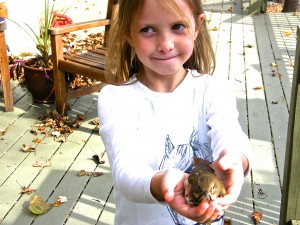I can be standing five feet from my girls and say something simple like, “wash your hands,” “brush your teeth” or “clean your room,” and not even an eyebrow will twitch in acknowledgement. But put those same g irls down in the basement with TV or ipad/pod blaring at decibels that would make NASCAR jealous and the tiniest thump at a window anywhere in the house will bring them flying upstairs clamoring, “Dad, did you hear that? Sounded like a bird hit the window.”
irls down in the basement with TV or ipad/pod blaring at decibels that would make NASCAR jealous and the tiniest thump at a window anywhere in the house will bring them flying upstairs clamoring, “Dad, did you hear that? Sounded like a bird hit the window.”
We get our share of window strikes but fortunately because most of the vegetation they launch from is near the house, most strikes are not fatal. Izzy and Maddie, my daughters, have gotten pretty good at finding birds after a collision, then bringing them inside, placing them in a box or container of some sort with a towel, etc. for warmth, then putting them in a dark quiet place and letting them rest. Usually, not in every case but usually, by then the patient has fully recovered and is anxious to get on about his/her business.
The other morning, Saturday I believe, I was down in the basement working. When I went upstairs, I was informed that Izzy and Maddie had a bird that had struck a window (and I didn’t hear a thing?) in the back bedroom. I went in to take a look and immediately noted a hermit thrush. Then I sat down on the bed next to Izzy who was holding the bird and got to thinking – “hmm – it’s really dull olive-brown and maybe that tail isn’t quite rufous enough.” You remember “Butch Cassidy and the Sundance Kid?” When the Kid was struggling with target practice and asked if he could “move.” Sometimes I feel that way with birds when looking at photos or with bird-in-hand when it comes to species that can be confusing, say like empidonax flycatchers or perched accipiters or immature Bicknell’s and hermit thrushes – if they would just move and/or call.
For me it’s much easier and quicker to positively ID a bird that is animated – doing what birds do. The characters, characteristics, habits, voice, etc. all flow together intuitively to point to a single species. It’s not as easy for me when I have to consciously note identifying characteristics – is there an eyering; wingbars; is the lower mandible black or yellow; are the legs thick or toothpick skinny – sometimes one has to go through such a checklist, but it sure is easier if they “move.”
And there was a moment last Saturday morning when the dull color of our bird created a fleeting thought – “wonder if it could be a late Bicknell’s?” But the bold white eyering and (when it was animated) the truly rufous rump and tail sealed the hermit thrush ID. And it makes more sense too as hermits will be with us all winter.
Most hermit thrushes nest in Alaska, Canada and the northeastern U.S. But there are a few that make it down the Appalachians. They can be found nesting regularly around Mt. Mitchell and off the Heintooga Spur Road near Poll’s Gap. In the winter they might turn up anywhere – forested thickets, parks and/or backyards. I don’t believe I’ve ever been to the Land Trust for the Little Tennessee’s Tessentee Bottomland Preserve during the winter without recording them.
